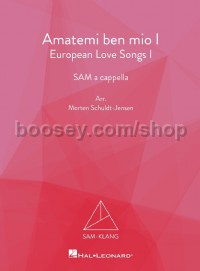Amatemi ben mio I (SAM a Cappella)
Amatemi ben mio I (SAM a Cappella)
Bulk Discounts Available
* Estimated price converted from UK retail price
This collection of works from the European Renaissance brings together five songs and madrigals to be sung in Italian, German, French and Dutch.
Claudio Monteverdi’s Lasciatemi morire started life as part of an extended operatic aria from the now lost opera L’Arianna. In 1614, Monteverdi published an arrangement of ‘Arianna’s Lament’ as a four-section madrigal for five voices, of which this is the first. Luca Marenzio’s Amatemi ben mio, a setting of text by the Italian poet Torquato Tasso, was first published in Il quarto libro delle villanelle a tre voci in 1587. It was his collection, Musica Transalpina, published a year later, that stimulated the proliferation of madrigal singing and composition in England. Pierre Passereau’s Il est bel et bon is an onomatopoeic chanson first published in 1534 that depicts two women gossiping about one of their husbands who is mocked for doing the household chores and feeding the chickens. The song’s bucolic character is typical of popular music in France and the Low Countries in the 1530s, which was often laced with double entendre and obscenity. Hans Leo Hassler’s Tanzen und springen, a work made famous by the King’s Singers 1983disc, Madrigal History Tour, is from the composer’s most renowned collection of lieder, Lustgarten neuer teutscher Gesäng Balletti, Galliarden und Intraden. Als ic u vinde by Hubert Waelrant is very much in the style of an Italian frottola (not dissimilar to the French chansons composed by Passereau). Waelrant, a member of the Franco-Flemish school, may have studied in Italy in his early years, as this secular gem and one of his most endearing works suggests.
Editorial Note: Some pieces in this volume feature brackets that comprise ‘ternary cells’ – cells of three beats – of differing lengths. Before the mid-17th century in the stile antico, it was common for each vocal line to have an independent stress pattern: a sequence of binary or ternary accentuations guided by the declamation of the text in order to give life to each voice.
Despite the non-legato of the individual single layer – created by elements including the musical articulation, the (hairpin) phrasing of the ternary cells and a natural text declamation – the constant displacement of stresses between the voices provides an overall feeling of flow right through to the next cadence, at which point the ‘cells’ come together.
Certain characteristics of this style, such as hemiolas and cadential conventions, continued in the following centuries and can be found in the music of Haydn, Mozart, Schubert and Brahms, and even later composers with an affinity for vocal polyphony. The voices in these SAM arrangements take on more than just their own polyphonic role, occasionally switching between parts to maintain the integrity of the original music.
Despite the initial challenges the removal of a part would suggest, choirs will reap the benefits of replicating the contrast and vitality of the original inner textural phrasing, and although the brackets and absence of normal bar lines may seem very different from a conventional edition, we are confident that any initial difficulties should be quickly overcome, and that the resulting quality and transparency of performance will be considerably more satisfying for both singer and listener.




